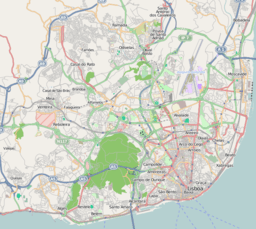Coliseu dos Recreios
| Coliseum of Lisbon (Coliseu dos Recreios) | |
| Coliseu de Lisboa | |
| Concert hall (Sala de espectáculos polivalente) | |
| Official name: Coliseu dos Recreios/Coliseu de Lisboa | |
| Country | |
|---|---|
| Region | Lisbon |
| Subregion | Grande Lisboa |
| District | Lisbon |
| Municipality | Lisbon |
| Location | Arroios |
| - coordinates | PT 38°43′00.30″N 9°8′24.60″W / 38.7167500°N 9.1401667°WCoordinates: PT 38°43′00.30″N 9°8′24.60″W / 38.7167500°N 9.1401667°W |
| Architect | Cesare Ianz (1888-1890), Francisco Goulard (1888-1890), José Luís Monteiro (1897), Maurício de Vasconcelos |
| Style | Modern architecture |
| Materials | Tile, Limestone, Steel |
| For public | Public |
| Easiest access | Rua das Portas de Santo Antão, 92-104; Beco de São Luís da Pena, 18-32 |
| Management | Instituto Gestão do Patrimonio Arquitectónico e Arqueológico |
| Operator | Câmara Municipal do Porto |
| Status | Property of Public Interest |
| Listing | Decree 2/96, Diário da República, Série-B, 56 6 March 1996; Included in the General Protection Zone for the Avenida da Liberdade (IPA.00005972); Included in the Special Protection Zone of the Group of Classified Properties of the Avenida da Liberdade and surrounding area; Partially included in the Protection Zone of the Castle of São Jorge and surrounding walls of Lisbon (IPA.00003128); and Protection Zone of the Monastery of Encarnação (IPA.00002535) |
 Location of the concert hall within the municipality of Lisbon
| |
| Website: http://www.coliseulisboa.com/ | |
The Coliseum of Lisbon (Portuguese: Coliseu dos Recreios/Coliseu de Lisboa) is a concert hall and venue located along Rua das Portas de Santo Antão/Beco de São Luís da Pena, in the civil parish of Arroios, in the municipality of in Lisbon (the Portuguese capital.
History
The main building was constructed within a metal lattice by Francisco Goulard between 1888 and 1890.[1] While the facade was completed by Cesare Ianz.[1] The building was inaugurated on 14 August 1890.[1] In 1897 the Sociedade de Geografia de Lisboa (Geographical Society of Lisbon) occupied part of the spaces, inaugurating the Sala Portugal (Portuguese Hall), authored by architect José Luís Monteiro (1849-1942) shortly after. António Santos Júnior became director general of the Coliseu dos Recreios in the same year.[1]
On the death of António Santos (1920), the direction of the Coliseu was assumed by Ricardo Covões.[1]
A major refurbishment of the installations was completed in February 1994, that included remodelling of the hall and stage, and reconstruction of the surrounding spaces.[1]
On 22 August 2006, the Coliseu (owing to its stylistic, typological and historic importance) was designated for preservation.[1] The DRCLisboa, on establishing the Special Protection Zone for the Castle of São Jorge (and surroundings), included the building.[1] As a Property of Public Interest, the National Council for Culture (Portuguese: Conselho Nacional de Cultura) proposed that archiving of the Special Protection Zone on 10 October 2011, which were recessitated on 18 October 2011 by IGESPAR.[1]
Architecture

The Coliseu is, actually two juxtopositioned buildings. This includes a rectangular three-story building, whose principal facade is oriented to the southwest. The first floor includes the Coliseu dos Recreios' atrium (94-98), the vestibule and bar-restaurant of the Sociedade de Geografia; the second floor, which as functions as library of the organization; and third floor, the Sala Portugal.[1] The rectangular area is internally divided into three areas supported by steel pillars/columns, and interlinked by steel staircase, allowing circulation vertically.[1] The twelve-sided events hall is encircled by seating and two floors of boxseating. To the northeast and southwest, respectively, are special boxseats, framed by three arches, over one of the three accesses. The hall is covred by metal ceiling, supported by steel tubing.[1]
The events hall has a capacity of between 2846 (seated) to 4000 people, depending on its configuration.
Beside concerts, other shows are hosted there, including theatre, circus, dance shows and awards ceremonies. Performers have included Cirque du Soleil, Tango Fire, and several ballets.
References
- Notes
- Sources
- 75 Anos de Actividades ao Serviço da Ciência e da Nação. 1875 - 1950 (in Portuguese), Lisbon, Portugal, 1950
- França, José-Augusto (1966), A Arte em Portugal no Séc. XIX (in Portuguese), Lisbon, Portugal
- Almeida, D. Fernando de (1975), DRCLisboa, ed., Monumentos e Edifícios Notáveis do Distrito de Lisboa (in Portuguese), II, Lisbon, Portugal
- Ribeiro, M. Félix (1978), Os Mais Antigos Cinemas de Lisboa. 1896 - 1939 (in Portuguese), Lisbon, Portugal
- França, José-Augusto (1982), Arquitectura de Engenheiros (in Portuguese), Lisbon, Portugal
- AA VV, ed. (1987), Guia Urbanístico e Arquitectónico de Lisboa (in Portuguese), Lisbon, Portugal
- Pedeirinho, José Manuel (1994), Dicionário de arquitectos activos em Portugal do Séc. I à actualidade (in Portuguese), Porto, Portugal: Edições Afrontamento